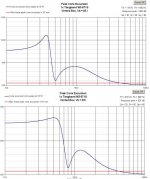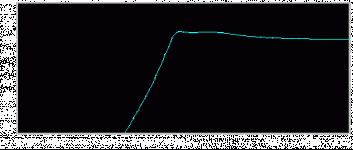10W per 871 is safe, I agree. I Consider 20W for TB3 that uses 2 871s ok.
Soongsc
The light blue curve is gonna be best if you lower your coil by 25% and listen. Your upper registers look over compensated.
Soongsc
but I did not take time to tune it to it's full potential because the highs were somehwhat lacking in detail.
The light blue curve is gonna be best if you lower your coil by 25% and listen. Your upper registers look over compensated.
salas said:10W per 871 is safe, I agree. I Consider 20W for TB3 that uses 2 871s ok.
Soongsc
The light blue curve is gonna be best if you lower your coil by 25% and listen. Your upper registers look over compensated.
salas,
Don't quite understand what part of the upper registers you refer to.
Almost any music material has really significant output in the 40/45-70 Hz region. Since designing speakers is about trade-offs, I propose to tune such drivers in the 50-60 Hz region to exploit the fact that in the system tuning frequency (and nearby) the needed excursion significantly decreases, and then find ways to strengthen the output in the upper bass (placing speakers near walls, using a somewhat bigger enclosure). The trick seems to work nice with these tangbands, and even a small level recession in the lows is sonically accepted since it is counterbalanced with its High-frequency power response roll-off -and also because of psychological reasons (knowing that the speaker is really small 🙂). You can’t have everything with a tiny fullrange driver, neither are such designs proposed for a big room’s free space great system or for producing some T-Rex footprints or an Organ’s lower registers, but you can have really acceptable, enjoyable and musical performance in normal listening levels, with a cunning placement.
Dear Destroyer, if you high pass them in 150 Hz you don’t get rid of excursion limitations regarding the next lower octave (75 to 150 Hz) in your alignment, but mostly regarding excursions in the 40-75 Hz region, as can be seen in the attached picture (together with the behavior of a 50 Hz tuning –the upper curve- which is a much better compromise – 10 Watts for each). It is there were your speaker bottoms with power given.
Last, I believe this discussion is not about “how to best use these tangbands in an open design”, since then I would answer “20 together as mid drivers in a 3 or even 4-way array”, but rather “how to produce a neat, enjoyable little speaker with this driver – is it possible?”. I answer to this: Yes it is;-)
Regards,
Thalis
Dear Destroyer, if you high pass them in 150 Hz you don’t get rid of excursion limitations regarding the next lower octave (75 to 150 Hz) in your alignment, but mostly regarding excursions in the 40-75 Hz region, as can be seen in the attached picture (together with the behavior of a 50 Hz tuning –the upper curve- which is a much better compromise – 10 Watts for each). It is there were your speaker bottoms with power given.
Last, I believe this discussion is not about “how to best use these tangbands in an open design”, since then I would answer “20 together as mid drivers in a 3 or even 4-way array”, but rather “how to produce a neat, enjoyable little speaker with this driver – is it possible?”. I answer to this: Yes it is;-)
Regards,
Thalis
Attachments
salas said:3k-10k. They have got to reach the mean average of your power range 200-800 Hz.
And you are referring to the "light" blue curve?
salas said:Yes, try to lighten the BSC on the light blue curve. I would start by 25%.
Sounds like something interesting to experiment with, but I doubt it'll beat the red.
The red line has the benefit of sensitivity. A most important trait for a small speaker. Showing dynamics, it may well lend itself to the ear as more forceful in general. Many times we say 'bass' and we mean transient response, efficiency between100-300Hz, sensitivity, dynamic contrasts etc. Also the bass overtones define much of its very known existence and presence.
Just experiment with the blue line and be generous with lightening the BSC at least 25% (you may end up with 50%). Listen without stress, compare, and let us know in a few days.
Regards.
Just experiment with the blue line and be generous with lightening the BSC at least 25% (you may end up with 50%). Listen without stress, compare, and let us know in a few days.
Regards.
I got my two W3-871S drivers. They are really beautifull. Now they only thing I have to do is to get them sound as beautifull as they look like. I've been simulating with winISD and I was wondering what would be a good enclosure.
The yellow line is a closed one. The 2 grey lines are BR. The cone excursion are almost the same of all enclosures. There is only a great differents between the group delays of all three. At 80hz the light grey line has a group delay of 4.3mm and the dark grey has one of 8.3mm. What would you think is the best enclosure for this speaker or could I better build something totally different like a dipole or so?
PS: I want to use only two drivers.
An externally hosted image should be here but it was not working when we last tested it.
The yellow line is a closed one. The 2 grey lines are BR. The cone excursion are almost the same of all enclosures. There is only a great differents between the group delays of all three. At 80hz the light grey line has a group delay of 4.3mm and the dark grey has one of 8.3mm. What would you think is the best enclosure for this speaker or could I better build something totally different like a dipole or so?
PS: I want to use only two drivers.
The following curve is for 3.6lt including allowance for speaker and tube volume. Use wool felt pads all around and a little foam on the back.
Its based on experimental data for the 871. It is calculated for one driver per cabinet. Dont use BSC if you adopt this alignment.
Also when you place it on your desktop know that the 200-300Hz region is going to develop a +5 dB bump. Cut this on your player EQ. You might need to boost 5-9kHz by 1 dB also.
The tube is 40mm total diam. and 70mm long.
Its based on experimental data for the 871. It is calculated for one driver per cabinet. Dont use BSC if you adopt this alignment.
Also when you place it on your desktop know that the 200-300Hz region is going to develop a +5 dB bump. Cut this on your player EQ. You might need to boost 5-9kHz by 1 dB also.
The tube is 40mm total diam. and 70mm long.
Attachments
salas said:The red line has the benefit of sensitivity. A most important trait for a small speaker. Showing dynamics, it may well lend itself to the ear as more forceful in general. Many times we say 'bass' and we mean transient response, efficiency between100-300Hz, sensitivity, dynamic contrasts etc. Also the bass overtones define much of its very known existence and presence.
Just experiment with the blue line and be generous with lightening the BSC at least 25% (you may end up with 50%). Listen without stress, compare, and let us know in a few days.
Regards.
It'll probably be another two full moons till I really can get those close to the reds, and still it would not have enough resolution. It was actually already very impressive though. Lots of things don't show up in these charts to really do a good tradeoff. It's like you just have to fly an airplane to know how good it handles and how it relates with the design (my old proffession).
True. If we could 'listen' to charts and specs we would be without a hobby. The 70's were nice for ABBA but not for hi-fi. Spec driven dark ages. We know better now, as they knew intuitively in the golden 50's. Its just better documented now.
I would make this 4cm diameter x 12cm Length and even somewhat longer if cabin had enough depth, or I would use a port of a little smaller diameter. Best of all, Douwe could experiment with various lengths; it’s the best way to decide.
Regards,
Thalis
Regards,
Thalis
I agree for a longer port if to go lower. I just stick to the initial threadstarte requirement of 80Hz F3 with caution to excursion.
Proberbly I'm going to build a BR that has it's -3dB point at 80hz. But what about a transmission line, I have heard they sound very good but they are also hard to build... I've also been thinking about a closed design(shouldn't it sound better?).
Closed design I have done and listened for a month. Its shallow for what 871 can offer. I prefer Visaton FRS8 for closed. Transmission, Tappered quarter wave, or mass loaded TQW are big for desktop.
How about this one
http://www.blueplanetacoustic.de/de/lautsprecherselbstbau/tisch_tml/index.html
they are full range, transmissionline, made of the TB W3-315S, very good as pc speakers on the table.
http://www.blueplanetacoustic.de/de/lautsprecherselbstbau/tisch_tml/index.html
they are full range, transmissionline, made of the TB W3-315S, very good as pc speakers on the table.
salas said:Closed design I have done and listened for a month. Its shallow for what 871 can offer. I prefer Visaton FRS8 for closed. Transmission, Tappered quarter wave, or mass loaded TQW are big for desktop.
Hi salas,
Could you please give some more info (fr, cabinet volme,...) about the "frs8 closed" ?
I'm thinking to use them for my pc and I'm searching for related info.
- Status
- Not open for further replies.
- Home
- Loudspeakers
- Full Range
- taking a W3-871S to 80 hertz

